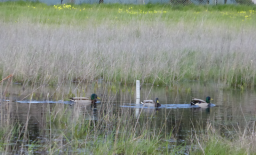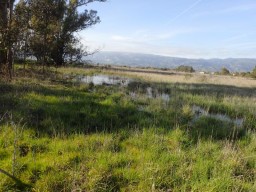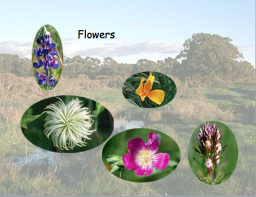More Mesa’s Vernal Pool … Full at Last

The southeast corner of More Mesa boasts one of the rarest, and most threatened, of natural communities: a vernal pool. Vernal pools form as a result of distinctive climate, soil and
topography, and are distinguished by the organisms they host. Many of these organisms are restricted to special habitats that flood temporarily in winter and early spring, then undergo a period of gradual drying and are dry the remainder of the year. Vernal pool plants and animals are adapted to these environmental extremes and as such, are among the most interesting organisms on earth. In winter the pools reach a maximum depth and duration of flooding and support numerous aquatic plants, insects, crustaceans and zooplankton; including rare and endangered species. In addition, amphibians such as Pacific Tree Frogs breed and lay eggs in the pools by the thousands. Vernal pools also provide a winter home for waterfowl during the rainy season.
Moreover, vernal pools are unique in another special way. Because they are isolated from one another and have a life span of only a few months, mutations that occur among a population in one pool are not likely to be dispersed to other populations. And since the number of vernal pools, and vernal pool sites are decreasing, the population associated with any one pool becomes more and more genetically isolated, and therefore unique. In the Santa Barbara coastal region, vernal pools occur at Ellwood Mesa, Isla Vista and UCSB and More Mesa – three distinctive areas.

These very special intermittent pools, found in many area of California, were once common to the Central Valley and other parts of the state. However vernal pools have been reduced to less than five percent of their original range, and now represent one of California’s most threatened natural communities. And … we have one of these precious sites here on our very own More Mesa*.
The last time the More Mesa vernal pool contained any appreciable water was in winter of 2011 … eight years ago! That year we had 147% of our annual rainfall. (As of this posting, in 2019, we have received slightly more than 100% of our annual rainfall.) In 2011 we collected samples and transferred them to UCSB’s CCBER (Cheadle Center for Biodiversity and Ecological Restoration) for analysis. At that time, a plan was conceived to sample the pool periodically, every year, in order to assess the life forms and determine what was happening in our More Mesa vernal pool. And then came the drought! Unhappily, with the drought there was no water, and therefore no sampling. However, we are pleased to report that this year a sampling program is already underway to study the organisms in the More Mesa vernal pool. A UCSB graduate student studying vernal pool restoration is working with CCBER to collect weekly data for water analysis. She also samples for invertebrates and surveys the vegetation. The survey has just started and we will keep you posted on findings.
* Vernal pools occur only where soils are derived from bedrock of shale that produces an accumulation of water above the water table and results in ponding after sufficient rainfall. This situation is different from soil derived from sandstone that allows infiltration of rainfall. Most of More Mesa is underlain by sandstone, so even at More Mesa the opportunity for vernal pools to form is restricted to a small area. To learn even more about these extraordinary habitats, see the Vernal Pool feature on our website.
And More About Water

Water Bars – Along with our long awaited rain, an open area such as More Mesa is likely to get significant trail erosion. However, if you are hiking out on More Mesa this season you will observe many water bars along all the trails. These features were described in detail in an update two years ago and are courtesy of an environmental hero who looks after our tails every time we get significant rainfall. Thank you whoever you are!
Wildflowers – We are already seeing some wildflowers in different areas around More Mesa. Most of them are not natives, but they are still very lovely to look at! If you would like to find out more about flowers on More Mesa, you can peruse our website sections under the “Plants” menu. There you can check out “Photos” of native wildflowers and maybe even identify the ones below. You can also look into how to “Garden With Native Plants” and “Invasive Plants” to help you plan your next native plant garden.

